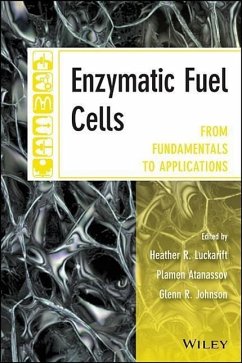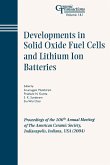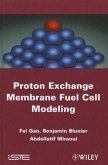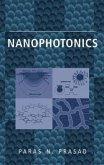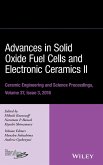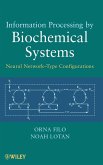Enzymatic Fuel Cells
From Fundamentals to Applications
Herausgeber: Luckarift, Heather R; Johnson, Glenn R; Atanassov, Plamen B
Enzymatic Fuel Cells
From Fundamentals to Applications
Herausgeber: Luckarift, Heather R; Johnson, Glenn R; Atanassov, Plamen B
- Gebundenes Buch
- Merkliste
- Auf die Merkliste
- Bewerten Bewerten
- Teilen
- Produkt teilen
- Produkterinnerung
- Produkterinnerung
A thorough and illuminating look at enzymatic fuel cells and their place in our current and future world With their use in biomedical applications and for portable electronics, enzymatic fuel cells offer an alternative power source to meet our world's increasing energy demands. Outlining the fundamentals, design, optimization, integration, and future trends of enzymatic fuel cells, Enzymatic Fuel Cells: From Fundamentals to Applications presents a comprehensive overview of enzymatic fuel cell research--with a special emphasis on methodology, fabrication, integration, and testing of enzymatic…mehr
Andere Kunden interessierten sich auch für
![Handbook of Chemicals and Gases for the Semiconductor Industry Handbook of Chemicals and Gases for the Semiconductor Industry]() Ashutosh MisraHandbook of Chemicals and Gases for the Semiconductor Industry348,99 €
Ashutosh MisraHandbook of Chemicals and Gases for the Semiconductor Industry348,99 €![Developments in Solid Oxide Fuel Cells and Lithium Ion Batteries Developments in Solid Oxide Fuel Cells and Lithium Ion Batteries]() Developments in Solid Oxide Fuel Cells and Lithium Ion Batteries158,99 €
Developments in Solid Oxide Fuel Cells and Lithium Ion Batteries158,99 €![Proton Exchange Membrane Fuel Cells Modeling Proton Exchange Membrane Fuel Cells Modeling]() Fengge GaoProton Exchange Membrane Fuel Cells Modeling194,99 €
Fengge GaoProton Exchange Membrane Fuel Cells Modeling194,99 €![Nanophotonics Nanophotonics]() Paras N. PrasadNanophotonics166,99 €
Paras N. PrasadNanophotonics166,99 €![Advances in Solid Oxide Fuel Cells and Electronic Ceramics II, Volume 37, Issue 3 Advances in Solid Oxide Fuel Cells and Electronic Ceramics II, Volume 37, Issue 3]() Advances in Solid Oxide Fuel Cells and Electronic Ceramics II, Volume 37, Issue 3276,99 €
Advances in Solid Oxide Fuel Cells and Electronic Ceramics II, Volume 37, Issue 3276,99 €![Advances in Solid Oxide Fuel Cells X, Volume 35, Issue 3 Advances in Solid Oxide Fuel Cells X, Volume 35, Issue 3]() Advances in Solid Oxide Fuel Cells X, Volume 35, Issue 3190,99 €
Advances in Solid Oxide Fuel Cells X, Volume 35, Issue 3190,99 €![Information Processing Information Processing]() Orna FiloInformation Processing107,99 €
Orna FiloInformation Processing107,99 €-
-
-
A thorough and illuminating look at enzymatic fuel cells and their place in our current and future world With their use in biomedical applications and for portable electronics, enzymatic fuel cells offer an alternative power source to meet our world's increasing energy demands. Outlining the fundamentals, design, optimization, integration, and future trends of enzymatic fuel cells, Enzymatic Fuel Cells: From Fundamentals to Applications presents a comprehensive overview of enzymatic fuel cell research--with a special emphasis on methodology, fabrication, integration, and testing of enzymatic fuel cells. The book provides introductory reading with a concise scheme of illustrations and: * Covers fundamentals of enzymatic fuel cells as well as their design, optimization, and integration * Introduces the reader to the scientific aspects of bioelectrochemistry and the unique engineering problems of enzymatic fuel cells * Offers an outlook on the practical applications of enzymatic fuel cells such as powering of microdevices, biomedical applications, and in autonomous systems * Details future developments and emerging applications of enzymatic fuel cells Enzymatic Fuel Cells is an ideal book for readers in the areas of electrochemistry, biochemistry, materials science, biosensors, biotechnology, environmental and chemical engineering, wastewater, and biology.
Hinweis: Dieser Artikel kann nur an eine deutsche Lieferadresse ausgeliefert werden.
Hinweis: Dieser Artikel kann nur an eine deutsche Lieferadresse ausgeliefert werden.
Produktdetails
- Produktdetails
- Verlag: Wiley
- Seitenzahl: 496
- Erscheinungstermin: 27. Mai 2014
- Englisch
- Abmessung: 239mm x 160mm x 30mm
- Gewicht: 862g
- ISBN-13: 9781118369234
- ISBN-10: 1118369238
- Artikelnr.: 40053585
- Herstellerkennzeichnung
- Libri GmbH
- Europaallee 1
- 36244 Bad Hersfeld
- gpsr@libri.de
- Verlag: Wiley
- Seitenzahl: 496
- Erscheinungstermin: 27. Mai 2014
- Englisch
- Abmessung: 239mm x 160mm x 30mm
- Gewicht: 862g
- ISBN-13: 9781118369234
- ISBN-10: 1118369238
- Artikelnr.: 40053585
- Herstellerkennzeichnung
- Libri GmbH
- Europaallee 1
- 36244 Bad Hersfeld
- gpsr@libri.de
HEATHER R. LUCKARIFT is the Senior Research Scientist for Universal Technology Corporation at the Air Force Civil Engineer Center (formerly the Microbiology & Applied Biochemistry team at the Air Force Research Laboratory). She is the author of over fifty peer-reviewed publications and invited reviews. PLAMEN ATANASSOV is a Professor of Chemical & Nuclear Engineering and the founding director of The University of New Mexico Center for Emerging Energy Technologies. He was the principal investigator on an Air Force Office of Scientific Research Multi-University Research Initiative program: "Fundamentals and Bioengineering of Enzymatic Fuel Cells." He is the author of more than 220 publications, including twelve reviews. GLENN R. JOHNSON is the Chief Scientist and founder of Hexpoint Technologies and the former principal investigator of the Microbiology & Applied Biochemistry team within the Air Force Research Laboratory. He is the author of over fifty peer-reviewed publications and invited reviews.
Preface xv
Contributors xvii
1 Introduction 1
Heather R. Luckarift, Plamen Atanassov, and Glenn R. Johnson
List of Abbreviations 3
2 Electrochemical Evaluation of Enzymatic Fuel Cells and Figures of Merit 4
Shelley D. Minteer, Heather R. Luckarift, and Plamen Atanassov
2.1 Introduction 4
2.2 Electrochemical Characterization 5
2.3 Outlook 9
Acknowledgment 10
List of Abbreviations 10
References 10
3 Direct Bioelectrocatalysis: Oxygen Reduction for Biological Fuel Cells 12
Dmitri M. Ivnitski, Plamen Atanassov, and Heather R. Luckarift
3.1 Introduction 12
3.2 Mechanistic Studies of Intramolecular Electron Transfer 13
3.3 Achieving DET of MCO by Rational Design 18
3.4 Outlook 25
Acknowledgments 26
List of Abbreviations 26
References 27
4 Anodic Catalysts for Oxidation of Carbon-Containing Fuels 33
Rosalba A. Rincón, Carolin Lau, Plamen Atanassov, and Heather R. Luckarift
4.1 Introduction 33
4.2 Oxidases 34
4.3 Dehydrogenases 35
4.4 PQQ-Dependent Enzymes 42
4.5 Outlook 44
Acknowledgment 45
List of Abbreviations 45
References 45
5 Anodic Bioelectrocatalysis: From Metabolic Pathways to Metabolons 53
Shuai Xu, Lindsey N. Pelster, Michelle Rasmussen, and Shelley D. Minteer
5.1 Introduction 53
5.2 Biological Fuels 53
5.3 Promiscuous Enzymes Versus Multienzyme Cascades Versus Metabolons 55
5.4 Direct and Mediated Electron Transfer 57
5.5 Fuels 58
5.6 Outlook 72
Acknowledgment 72
List of Abbreviations 73
References 73
6 Bioelectrocatalysis of Hydrogen Oxidation/Reduction by Hydrogenases 80
Anne K. Jones, Arnab Dutta, Patrick Kwan, Chelsea L. McIntosh, Souvik Roy,
and Sijie Yang
6.1 Introduction 80
6.2 Hydrogenases 81
6.3 Biological Fuel Cells Using Hydrogenases: Electrocatalysis 85
6.4 Electrocatalysis by Functional Mimics of Hydrogenases 92
6.5 Outlook 97
Acknowledgments 98
List of Abbreviations 98
References 99
7 Protein Engineering for Enzymatic Fuel Cells 109
Elliot Campbell and Scott Banta
7.1 Engineering Enzymes for Catalysis 109
7.2 Engineering Other Properties of Enzymes 112
7.3 Enzyme Immobilization and Self-Assembly 115
7.4 Artificial Metabolons 117
7.5 Outlook 118
List of Abbreviations 118
References 118
8 Purification and Characterization of Multicopper Oxidases for Enzyme
Electrodes 123
D. Matthew Eby and Glenn R. Johnson
8.1 Introduction 123
8.2 General Considerations for MCO Expression and Purification 124
8.3 MCO Production and Expression Systems 125
8.4 MCO Purification 128
8.5 Copper Stability and Specific Considerations for MCO Production 133
8.6 Spectroscopic Monitoring and Characterization of Copper Centers 136
8.7 Outlook 139
Acknowledgment 140
List of Abbreviations 140
References 140
9 Mediated Enzyme Electrodes 146
Joshua W. Gallaway
9.1 Introduction 146
9.2 Fundamentals 147
9.3 Types of Mediation 152
9.4 Aspects of Mediator Design I: Mediator Overpotentials 162
9.5 Aspects of Mediator Design II: Saturated Mediator Kinetics 165
9.6 Outlook 172
List of Abbreviations 172
References 172
10 Hierarchical Materials Architectures for Enzymatic Fuel Cells 181
Guinevere Strack and Glenn R. Johnson
10.1 Introduction 181
10.2 Carbon Nanomaterials and the Construction of the Bio-Nano Interface
184
10.3 Biotemplating: The Assembly of Nanostructured Biological-Inorganic
Materials 191
10.4 Fabrication of Hierarchically Ordered 3D Materials for Enzyme and
Microbial Electrodes 194
10.5 Incorporating Conductive Polymers into Bioelectrodes for Fuel Cell
Applications 198
10.6 Outlook 201
Acknowledgment 201
List of Abbreviations 201
References 202
11 Enzyme Immobilization for Biological Fuel Cell Applications 208
Lorena Betancor and Heather R. Luckarift
11.1 Introduction 208
11.2 Immobilization by Physical Methods 209
11.3 Entrapment as a Pre- and Post-Immobilization Strategy 211
11.4 Enzyme Immobilization via Chemical Methods 213
11.5 Orientation Matters 216
11.6 Outlook 218
Acknowledgment 219
List of Abbreviations 219
References 219
12 Interrogating Immobilized Enzymes in Hierarchical Structures 225
Michael J. Cooney and Heather R. Luckarift
12.1 Introduction 225
12.2 Estimating the Bound Active (Redox) Enzyme 227
12.3 Probing the Distribution of Immobilized Enzyme Within Hierarchical
Structures 232
12.4 Probing the Immediate Chemical Microenvironments of Enzymes in
Hierarchical Structures 235
12.5 Enzyme Aggregation in a Hierarchical Structure 236
12.6 Outlook 238
Acknowledgment 239
List of Abbreviations 239
References 239
13 Imaging and Characterization of the Bio-Nano Interface 242
Karen E. Farrington, Heather R. Luckarift, D. Matthew Eby, and Kateryna
Artyushkova
13.1 Introduction 242
13.2 Imaging the Bio-Nano Interface 243
13.3 Characterizing the Bio-Nano Interface 248
13.4 Interrogating the Bio-Nano Interface 256
13.5 Outlook 267
Acknowledgment 267
List of Abbreviations 267
References 268
14 Scanning Electrochemical Microscopy for Biological Fuel Cell
Characterization 273
Ramaraja P. Ramasamy
14.1 Introduction 273
14.2 Theory and Operation 274
14.3 Ultramicroelectrodes 275
14.4 Modes of SECM Operation 278
14.5 SECM for BFC Anodes 281
14.6 SECM for BFC Cathodes 285
14.7 Catalyst Screening Using SECM 290
14.8 SECM for Membranes 291
14.9 Probing Single Enzyme Molecules Using SECM 293
14.10 Combining SECM with Other Techniques 293
14.11 Outlook 297
List of Abbreviations 297
References 298
15 In Situ X-Ray Spectroscopy of Enzymatic Catalysis: Laccase-Catalyzed
Oxygen Reduction 304
Sanjeev Mukerjee, Joseph Ziegelbauer, Thomas M. Arruda, Kateryna
Artyushkova, and Plamen Atanassov
15.1 Introduction 304
15.2 Defining the Enzyme/Electrode Interface 305
15.3 Direct Electron Transfer Versus Mediated Electron Transfer 306
15.4 The Blue Copper Oxidases 308
15.5 In Situ XAS 310
15.6 Proposed ORR Mechanism 327
15.7 Outlook 331
Acknowledgments 331
List of Abbreviations 331
References 332
16 Enzymatic Fuel Cell Design, Operation, and Application 337
Vojtech Svoboda and Plamen Atanassov
16.1 Introduction 337
16.2 Biobatteries and EFCs 338
16.3 Components 339
16.4 Single-Cell Design 345
16.5 Microfluidic EFC Design 348
16.6 Stacked Cell Design 348
16.7 Bipolar Electrodes 350
16.8 Air/Oxygen Supply 351
16.9 Fuel Supply 351
16.10 Storage and Shelf Life 356
16.11 EFC Operation, Control, and Integration with Other Power Sources 356
16.12 EFC Control 357
16.13 Power Conditioning 357
16.14 Outlook 358
List of Abbreviations 359
References 359
17 Miniature Enzymatic Fuel Cells 361
Takeo Miyake and Matsuhiko Nishizawa
17.1 Introduction 361
17.2 Insertion MEFC 362
17.3 Microfluidic MEFC 366
17.4 Flexible Sheet MEFC 370
17.5 Outlook 371
List of Abbreviations 372
References 372
18 Switchable Electrodes and Biological Fuel Cells 374
Evgeny Katz, Vera Bocharova, and Jan Halámek
18.1 Introduction 374
18.2 Switchable Electrodes for Bioelectronic Applications 375
18.3 Light-Switchable Modified Electrodes Based on Photoisomerizable
Materials 376
18.4 Magnetoswitchable Electrochemical Reactions Controlled by Magnetic
Species Associated with Electrode Interfaces 378
18.5 Modified Electrodes Switchable by Applied Potentials Resulting in
Electrochemical Transformations at Functional Interfaces 381
18.6 Chemically/Biochemically Switchable Electrodes 383
18.7 Coupling of Switchable Electrodes with Biomolecular Computing Systems
389
18.8 BFCs with Switchable/Tunable Power Output 396
18.9 Outlook 412
Acknowledgments 413
List of Abbreviations 413
References 414
19 Biological Fuel Cells for Biomedical Applications 422
Magnus Falk, Sergey Shleev, Claudia W. Narváez Villarrubia, Sofia Babanova,
and Plamen Atanassov
19.1 Introduction 422
19.2 Definition and Classification of BFCs 424
19.3 Design Aspects of EFCs 427
19.4 In Vitro and In Vivo BFC Studies 433
19.5 Outlook 440
List of Abbreviations 442
References 443
20 Concluding Remarks and Outlook 451
Glenn R. Johnson, Heather R. Luckarift, and Plamen Atanassov
20.1 Introduction 451
20.2 Primary System Engineering: Design Determinants 453
20.3 Fundamental Advances in Bioelectrocatalysis 454
20.4 Design Opportunities from EFC Operation 454
20.5 Fundamental Drivers for EFC Miniaturization 455
20.6 Commercialization of EFCs: Strategies and Opportunities 455
Acknowledgment 457
List of Abbreviations 457
References 457
Index 459
Contributors xvii
1 Introduction 1
Heather R. Luckarift, Plamen Atanassov, and Glenn R. Johnson
List of Abbreviations 3
2 Electrochemical Evaluation of Enzymatic Fuel Cells and Figures of Merit 4
Shelley D. Minteer, Heather R. Luckarift, and Plamen Atanassov
2.1 Introduction 4
2.2 Electrochemical Characterization 5
2.3 Outlook 9
Acknowledgment 10
List of Abbreviations 10
References 10
3 Direct Bioelectrocatalysis: Oxygen Reduction for Biological Fuel Cells 12
Dmitri M. Ivnitski, Plamen Atanassov, and Heather R. Luckarift
3.1 Introduction 12
3.2 Mechanistic Studies of Intramolecular Electron Transfer 13
3.3 Achieving DET of MCO by Rational Design 18
3.4 Outlook 25
Acknowledgments 26
List of Abbreviations 26
References 27
4 Anodic Catalysts for Oxidation of Carbon-Containing Fuels 33
Rosalba A. Rincón, Carolin Lau, Plamen Atanassov, and Heather R. Luckarift
4.1 Introduction 33
4.2 Oxidases 34
4.3 Dehydrogenases 35
4.4 PQQ-Dependent Enzymes 42
4.5 Outlook 44
Acknowledgment 45
List of Abbreviations 45
References 45
5 Anodic Bioelectrocatalysis: From Metabolic Pathways to Metabolons 53
Shuai Xu, Lindsey N. Pelster, Michelle Rasmussen, and Shelley D. Minteer
5.1 Introduction 53
5.2 Biological Fuels 53
5.3 Promiscuous Enzymes Versus Multienzyme Cascades Versus Metabolons 55
5.4 Direct and Mediated Electron Transfer 57
5.5 Fuels 58
5.6 Outlook 72
Acknowledgment 72
List of Abbreviations 73
References 73
6 Bioelectrocatalysis of Hydrogen Oxidation/Reduction by Hydrogenases 80
Anne K. Jones, Arnab Dutta, Patrick Kwan, Chelsea L. McIntosh, Souvik Roy,
and Sijie Yang
6.1 Introduction 80
6.2 Hydrogenases 81
6.3 Biological Fuel Cells Using Hydrogenases: Electrocatalysis 85
6.4 Electrocatalysis by Functional Mimics of Hydrogenases 92
6.5 Outlook 97
Acknowledgments 98
List of Abbreviations 98
References 99
7 Protein Engineering for Enzymatic Fuel Cells 109
Elliot Campbell and Scott Banta
7.1 Engineering Enzymes for Catalysis 109
7.2 Engineering Other Properties of Enzymes 112
7.3 Enzyme Immobilization and Self-Assembly 115
7.4 Artificial Metabolons 117
7.5 Outlook 118
List of Abbreviations 118
References 118
8 Purification and Characterization of Multicopper Oxidases for Enzyme
Electrodes 123
D. Matthew Eby and Glenn R. Johnson
8.1 Introduction 123
8.2 General Considerations for MCO Expression and Purification 124
8.3 MCO Production and Expression Systems 125
8.4 MCO Purification 128
8.5 Copper Stability and Specific Considerations for MCO Production 133
8.6 Spectroscopic Monitoring and Characterization of Copper Centers 136
8.7 Outlook 139
Acknowledgment 140
List of Abbreviations 140
References 140
9 Mediated Enzyme Electrodes 146
Joshua W. Gallaway
9.1 Introduction 146
9.2 Fundamentals 147
9.3 Types of Mediation 152
9.4 Aspects of Mediator Design I: Mediator Overpotentials 162
9.5 Aspects of Mediator Design II: Saturated Mediator Kinetics 165
9.6 Outlook 172
List of Abbreviations 172
References 172
10 Hierarchical Materials Architectures for Enzymatic Fuel Cells 181
Guinevere Strack and Glenn R. Johnson
10.1 Introduction 181
10.2 Carbon Nanomaterials and the Construction of the Bio-Nano Interface
184
10.3 Biotemplating: The Assembly of Nanostructured Biological-Inorganic
Materials 191
10.4 Fabrication of Hierarchically Ordered 3D Materials for Enzyme and
Microbial Electrodes 194
10.5 Incorporating Conductive Polymers into Bioelectrodes for Fuel Cell
Applications 198
10.6 Outlook 201
Acknowledgment 201
List of Abbreviations 201
References 202
11 Enzyme Immobilization for Biological Fuel Cell Applications 208
Lorena Betancor and Heather R. Luckarift
11.1 Introduction 208
11.2 Immobilization by Physical Methods 209
11.3 Entrapment as a Pre- and Post-Immobilization Strategy 211
11.4 Enzyme Immobilization via Chemical Methods 213
11.5 Orientation Matters 216
11.6 Outlook 218
Acknowledgment 219
List of Abbreviations 219
References 219
12 Interrogating Immobilized Enzymes in Hierarchical Structures 225
Michael J. Cooney and Heather R. Luckarift
12.1 Introduction 225
12.2 Estimating the Bound Active (Redox) Enzyme 227
12.3 Probing the Distribution of Immobilized Enzyme Within Hierarchical
Structures 232
12.4 Probing the Immediate Chemical Microenvironments of Enzymes in
Hierarchical Structures 235
12.5 Enzyme Aggregation in a Hierarchical Structure 236
12.6 Outlook 238
Acknowledgment 239
List of Abbreviations 239
References 239
13 Imaging and Characterization of the Bio-Nano Interface 242
Karen E. Farrington, Heather R. Luckarift, D. Matthew Eby, and Kateryna
Artyushkova
13.1 Introduction 242
13.2 Imaging the Bio-Nano Interface 243
13.3 Characterizing the Bio-Nano Interface 248
13.4 Interrogating the Bio-Nano Interface 256
13.5 Outlook 267
Acknowledgment 267
List of Abbreviations 267
References 268
14 Scanning Electrochemical Microscopy for Biological Fuel Cell
Characterization 273
Ramaraja P. Ramasamy
14.1 Introduction 273
14.2 Theory and Operation 274
14.3 Ultramicroelectrodes 275
14.4 Modes of SECM Operation 278
14.5 SECM for BFC Anodes 281
14.6 SECM for BFC Cathodes 285
14.7 Catalyst Screening Using SECM 290
14.8 SECM for Membranes 291
14.9 Probing Single Enzyme Molecules Using SECM 293
14.10 Combining SECM with Other Techniques 293
14.11 Outlook 297
List of Abbreviations 297
References 298
15 In Situ X-Ray Spectroscopy of Enzymatic Catalysis: Laccase-Catalyzed
Oxygen Reduction 304
Sanjeev Mukerjee, Joseph Ziegelbauer, Thomas M. Arruda, Kateryna
Artyushkova, and Plamen Atanassov
15.1 Introduction 304
15.2 Defining the Enzyme/Electrode Interface 305
15.3 Direct Electron Transfer Versus Mediated Electron Transfer 306
15.4 The Blue Copper Oxidases 308
15.5 In Situ XAS 310
15.6 Proposed ORR Mechanism 327
15.7 Outlook 331
Acknowledgments 331
List of Abbreviations 331
References 332
16 Enzymatic Fuel Cell Design, Operation, and Application 337
Vojtech Svoboda and Plamen Atanassov
16.1 Introduction 337
16.2 Biobatteries and EFCs 338
16.3 Components 339
16.4 Single-Cell Design 345
16.5 Microfluidic EFC Design 348
16.6 Stacked Cell Design 348
16.7 Bipolar Electrodes 350
16.8 Air/Oxygen Supply 351
16.9 Fuel Supply 351
16.10 Storage and Shelf Life 356
16.11 EFC Operation, Control, and Integration with Other Power Sources 356
16.12 EFC Control 357
16.13 Power Conditioning 357
16.14 Outlook 358
List of Abbreviations 359
References 359
17 Miniature Enzymatic Fuel Cells 361
Takeo Miyake and Matsuhiko Nishizawa
17.1 Introduction 361
17.2 Insertion MEFC 362
17.3 Microfluidic MEFC 366
17.4 Flexible Sheet MEFC 370
17.5 Outlook 371
List of Abbreviations 372
References 372
18 Switchable Electrodes and Biological Fuel Cells 374
Evgeny Katz, Vera Bocharova, and Jan Halámek
18.1 Introduction 374
18.2 Switchable Electrodes for Bioelectronic Applications 375
18.3 Light-Switchable Modified Electrodes Based on Photoisomerizable
Materials 376
18.4 Magnetoswitchable Electrochemical Reactions Controlled by Magnetic
Species Associated with Electrode Interfaces 378
18.5 Modified Electrodes Switchable by Applied Potentials Resulting in
Electrochemical Transformations at Functional Interfaces 381
18.6 Chemically/Biochemically Switchable Electrodes 383
18.7 Coupling of Switchable Electrodes with Biomolecular Computing Systems
389
18.8 BFCs with Switchable/Tunable Power Output 396
18.9 Outlook 412
Acknowledgments 413
List of Abbreviations 413
References 414
19 Biological Fuel Cells for Biomedical Applications 422
Magnus Falk, Sergey Shleev, Claudia W. Narváez Villarrubia, Sofia Babanova,
and Plamen Atanassov
19.1 Introduction 422
19.2 Definition and Classification of BFCs 424
19.3 Design Aspects of EFCs 427
19.4 In Vitro and In Vivo BFC Studies 433
19.5 Outlook 440
List of Abbreviations 442
References 443
20 Concluding Remarks and Outlook 451
Glenn R. Johnson, Heather R. Luckarift, and Plamen Atanassov
20.1 Introduction 451
20.2 Primary System Engineering: Design Determinants 453
20.3 Fundamental Advances in Bioelectrocatalysis 454
20.4 Design Opportunities from EFC Operation 454
20.5 Fundamental Drivers for EFC Miniaturization 455
20.6 Commercialization of EFCs: Strategies and Opportunities 455
Acknowledgment 457
List of Abbreviations 457
References 457
Index 459
Preface xv
Contributors xvii
1 Introduction 1
Heather R. Luckarift, Plamen Atanassov, and Glenn R. Johnson
List of Abbreviations 3
2 Electrochemical Evaluation of Enzymatic Fuel Cells and Figures of Merit 4
Shelley D. Minteer, Heather R. Luckarift, and Plamen Atanassov
2.1 Introduction 4
2.2 Electrochemical Characterization 5
2.3 Outlook 9
Acknowledgment 10
List of Abbreviations 10
References 10
3 Direct Bioelectrocatalysis: Oxygen Reduction for Biological Fuel Cells 12
Dmitri M. Ivnitski, Plamen Atanassov, and Heather R. Luckarift
3.1 Introduction 12
3.2 Mechanistic Studies of Intramolecular Electron Transfer 13
3.3 Achieving DET of MCO by Rational Design 18
3.4 Outlook 25
Acknowledgments 26
List of Abbreviations 26
References 27
4 Anodic Catalysts for Oxidation of Carbon-Containing Fuels 33
Rosalba A. Rincón, Carolin Lau, Plamen Atanassov, and Heather R. Luckarift
4.1 Introduction 33
4.2 Oxidases 34
4.3 Dehydrogenases 35
4.4 PQQ-Dependent Enzymes 42
4.5 Outlook 44
Acknowledgment 45
List of Abbreviations 45
References 45
5 Anodic Bioelectrocatalysis: From Metabolic Pathways to Metabolons 53
Shuai Xu, Lindsey N. Pelster, Michelle Rasmussen, and Shelley D. Minteer
5.1 Introduction 53
5.2 Biological Fuels 53
5.3 Promiscuous Enzymes Versus Multienzyme Cascades Versus Metabolons 55
5.4 Direct and Mediated Electron Transfer 57
5.5 Fuels 58
5.6 Outlook 72
Acknowledgment 72
List of Abbreviations 73
References 73
6 Bioelectrocatalysis of Hydrogen Oxidation/Reduction by Hydrogenases 80
Anne K. Jones, Arnab Dutta, Patrick Kwan, Chelsea L. McIntosh, Souvik Roy,
and Sijie Yang
6.1 Introduction 80
6.2 Hydrogenases 81
6.3 Biological Fuel Cells Using Hydrogenases: Electrocatalysis 85
6.4 Electrocatalysis by Functional Mimics of Hydrogenases 92
6.5 Outlook 97
Acknowledgments 98
List of Abbreviations 98
References 99
7 Protein Engineering for Enzymatic Fuel Cells 109
Elliot Campbell and Scott Banta
7.1 Engineering Enzymes for Catalysis 109
7.2 Engineering Other Properties of Enzymes 112
7.3 Enzyme Immobilization and Self-Assembly 115
7.4 Artificial Metabolons 117
7.5 Outlook 118
List of Abbreviations 118
References 118
8 Purification and Characterization of Multicopper Oxidases for Enzyme
Electrodes 123
D. Matthew Eby and Glenn R. Johnson
8.1 Introduction 123
8.2 General Considerations for MCO Expression and Purification 124
8.3 MCO Production and Expression Systems 125
8.4 MCO Purification 128
8.5 Copper Stability and Specific Considerations for MCO Production 133
8.6 Spectroscopic Monitoring and Characterization of Copper Centers 136
8.7 Outlook 139
Acknowledgment 140
List of Abbreviations 140
References 140
9 Mediated Enzyme Electrodes 146
Joshua W. Gallaway
9.1 Introduction 146
9.2 Fundamentals 147
9.3 Types of Mediation 152
9.4 Aspects of Mediator Design I: Mediator Overpotentials 162
9.5 Aspects of Mediator Design II: Saturated Mediator Kinetics 165
9.6 Outlook 172
List of Abbreviations 172
References 172
10 Hierarchical Materials Architectures for Enzymatic Fuel Cells 181
Guinevere Strack and Glenn R. Johnson
10.1 Introduction 181
10.2 Carbon Nanomaterials and the Construction of the Bio-Nano Interface
184
10.3 Biotemplating: The Assembly of Nanostructured Biological-Inorganic
Materials 191
10.4 Fabrication of Hierarchically Ordered 3D Materials for Enzyme and
Microbial Electrodes 194
10.5 Incorporating Conductive Polymers into Bioelectrodes for Fuel Cell
Applications 198
10.6 Outlook 201
Acknowledgment 201
List of Abbreviations 201
References 202
11 Enzyme Immobilization for Biological Fuel Cell Applications 208
Lorena Betancor and Heather R. Luckarift
11.1 Introduction 208
11.2 Immobilization by Physical Methods 209
11.3 Entrapment as a Pre- and Post-Immobilization Strategy 211
11.4 Enzyme Immobilization via Chemical Methods 213
11.5 Orientation Matters 216
11.6 Outlook 218
Acknowledgment 219
List of Abbreviations 219
References 219
12 Interrogating Immobilized Enzymes in Hierarchical Structures 225
Michael J. Cooney and Heather R. Luckarift
12.1 Introduction 225
12.2 Estimating the Bound Active (Redox) Enzyme 227
12.3 Probing the Distribution of Immobilized Enzyme Within Hierarchical
Structures 232
12.4 Probing the Immediate Chemical Microenvironments of Enzymes in
Hierarchical Structures 235
12.5 Enzyme Aggregation in a Hierarchical Structure 236
12.6 Outlook 238
Acknowledgment 239
List of Abbreviations 239
References 239
13 Imaging and Characterization of the Bio-Nano Interface 242
Karen E. Farrington, Heather R. Luckarift, D. Matthew Eby, and Kateryna
Artyushkova
13.1 Introduction 242
13.2 Imaging the Bio-Nano Interface 243
13.3 Characterizing the Bio-Nano Interface 248
13.4 Interrogating the Bio-Nano Interface 256
13.5 Outlook 267
Acknowledgment 267
List of Abbreviations 267
References 268
14 Scanning Electrochemical Microscopy for Biological Fuel Cell
Characterization 273
Ramaraja P. Ramasamy
14.1 Introduction 273
14.2 Theory and Operation 274
14.3 Ultramicroelectrodes 275
14.4 Modes of SECM Operation 278
14.5 SECM for BFC Anodes 281
14.6 SECM for BFC Cathodes 285
14.7 Catalyst Screening Using SECM 290
14.8 SECM for Membranes 291
14.9 Probing Single Enzyme Molecules Using SECM 293
14.10 Combining SECM with Other Techniques 293
14.11 Outlook 297
List of Abbreviations 297
References 298
15 In Situ X-Ray Spectroscopy of Enzymatic Catalysis: Laccase-Catalyzed
Oxygen Reduction 304
Sanjeev Mukerjee, Joseph Ziegelbauer, Thomas M. Arruda, Kateryna
Artyushkova, and Plamen Atanassov
15.1 Introduction 304
15.2 Defining the Enzyme/Electrode Interface 305
15.3 Direct Electron Transfer Versus Mediated Electron Transfer 306
15.4 The Blue Copper Oxidases 308
15.5 In Situ XAS 310
15.6 Proposed ORR Mechanism 327
15.7 Outlook 331
Acknowledgments 331
List of Abbreviations 331
References 332
16 Enzymatic Fuel Cell Design, Operation, and Application 337
Vojtech Svoboda and Plamen Atanassov
16.1 Introduction 337
16.2 Biobatteries and EFCs 338
16.3 Components 339
16.4 Single-Cell Design 345
16.5 Microfluidic EFC Design 348
16.6 Stacked Cell Design 348
16.7 Bipolar Electrodes 350
16.8 Air/Oxygen Supply 351
16.9 Fuel Supply 351
16.10 Storage and Shelf Life 356
16.11 EFC Operation, Control, and Integration with Other Power Sources 356
16.12 EFC Control 357
16.13 Power Conditioning 357
16.14 Outlook 358
List of Abbreviations 359
References 359
17 Miniature Enzymatic Fuel Cells 361
Takeo Miyake and Matsuhiko Nishizawa
17.1 Introduction 361
17.2 Insertion MEFC 362
17.3 Microfluidic MEFC 366
17.4 Flexible Sheet MEFC 370
17.5 Outlook 371
List of Abbreviations 372
References 372
18 Switchable Electrodes and Biological Fuel Cells 374
Evgeny Katz, Vera Bocharova, and Jan Halámek
18.1 Introduction 374
18.2 Switchable Electrodes for Bioelectronic Applications 375
18.3 Light-Switchable Modified Electrodes Based on Photoisomerizable
Materials 376
18.4 Magnetoswitchable Electrochemical Reactions Controlled by Magnetic
Species Associated with Electrode Interfaces 378
18.5 Modified Electrodes Switchable by Applied Potentials Resulting in
Electrochemical Transformations at Functional Interfaces 381
18.6 Chemically/Biochemically Switchable Electrodes 383
18.7 Coupling of Switchable Electrodes with Biomolecular Computing Systems
389
18.8 BFCs with Switchable/Tunable Power Output 396
18.9 Outlook 412
Acknowledgments 413
List of Abbreviations 413
References 414
19 Biological Fuel Cells for Biomedical Applications 422
Magnus Falk, Sergey Shleev, Claudia W. Narváez Villarrubia, Sofia Babanova,
and Plamen Atanassov
19.1 Introduction 422
19.2 Definition and Classification of BFCs 424
19.3 Design Aspects of EFCs 427
19.4 In Vitro and In Vivo BFC Studies 433
19.5 Outlook 440
List of Abbreviations 442
References 443
20 Concluding Remarks and Outlook 451
Glenn R. Johnson, Heather R. Luckarift, and Plamen Atanassov
20.1 Introduction 451
20.2 Primary System Engineering: Design Determinants 453
20.3 Fundamental Advances in Bioelectrocatalysis 454
20.4 Design Opportunities from EFC Operation 454
20.5 Fundamental Drivers for EFC Miniaturization 455
20.6 Commercialization of EFCs: Strategies and Opportunities 455
Acknowledgment 457
List of Abbreviations 457
References 457
Index 459
Contributors xvii
1 Introduction 1
Heather R. Luckarift, Plamen Atanassov, and Glenn R. Johnson
List of Abbreviations 3
2 Electrochemical Evaluation of Enzymatic Fuel Cells and Figures of Merit 4
Shelley D. Minteer, Heather R. Luckarift, and Plamen Atanassov
2.1 Introduction 4
2.2 Electrochemical Characterization 5
2.3 Outlook 9
Acknowledgment 10
List of Abbreviations 10
References 10
3 Direct Bioelectrocatalysis: Oxygen Reduction for Biological Fuel Cells 12
Dmitri M. Ivnitski, Plamen Atanassov, and Heather R. Luckarift
3.1 Introduction 12
3.2 Mechanistic Studies of Intramolecular Electron Transfer 13
3.3 Achieving DET of MCO by Rational Design 18
3.4 Outlook 25
Acknowledgments 26
List of Abbreviations 26
References 27
4 Anodic Catalysts for Oxidation of Carbon-Containing Fuels 33
Rosalba A. Rincón, Carolin Lau, Plamen Atanassov, and Heather R. Luckarift
4.1 Introduction 33
4.2 Oxidases 34
4.3 Dehydrogenases 35
4.4 PQQ-Dependent Enzymes 42
4.5 Outlook 44
Acknowledgment 45
List of Abbreviations 45
References 45
5 Anodic Bioelectrocatalysis: From Metabolic Pathways to Metabolons 53
Shuai Xu, Lindsey N. Pelster, Michelle Rasmussen, and Shelley D. Minteer
5.1 Introduction 53
5.2 Biological Fuels 53
5.3 Promiscuous Enzymes Versus Multienzyme Cascades Versus Metabolons 55
5.4 Direct and Mediated Electron Transfer 57
5.5 Fuels 58
5.6 Outlook 72
Acknowledgment 72
List of Abbreviations 73
References 73
6 Bioelectrocatalysis of Hydrogen Oxidation/Reduction by Hydrogenases 80
Anne K. Jones, Arnab Dutta, Patrick Kwan, Chelsea L. McIntosh, Souvik Roy,
and Sijie Yang
6.1 Introduction 80
6.2 Hydrogenases 81
6.3 Biological Fuel Cells Using Hydrogenases: Electrocatalysis 85
6.4 Electrocatalysis by Functional Mimics of Hydrogenases 92
6.5 Outlook 97
Acknowledgments 98
List of Abbreviations 98
References 99
7 Protein Engineering for Enzymatic Fuel Cells 109
Elliot Campbell and Scott Banta
7.1 Engineering Enzymes for Catalysis 109
7.2 Engineering Other Properties of Enzymes 112
7.3 Enzyme Immobilization and Self-Assembly 115
7.4 Artificial Metabolons 117
7.5 Outlook 118
List of Abbreviations 118
References 118
8 Purification and Characterization of Multicopper Oxidases for Enzyme
Electrodes 123
D. Matthew Eby and Glenn R. Johnson
8.1 Introduction 123
8.2 General Considerations for MCO Expression and Purification 124
8.3 MCO Production and Expression Systems 125
8.4 MCO Purification 128
8.5 Copper Stability and Specific Considerations for MCO Production 133
8.6 Spectroscopic Monitoring and Characterization of Copper Centers 136
8.7 Outlook 139
Acknowledgment 140
List of Abbreviations 140
References 140
9 Mediated Enzyme Electrodes 146
Joshua W. Gallaway
9.1 Introduction 146
9.2 Fundamentals 147
9.3 Types of Mediation 152
9.4 Aspects of Mediator Design I: Mediator Overpotentials 162
9.5 Aspects of Mediator Design II: Saturated Mediator Kinetics 165
9.6 Outlook 172
List of Abbreviations 172
References 172
10 Hierarchical Materials Architectures for Enzymatic Fuel Cells 181
Guinevere Strack and Glenn R. Johnson
10.1 Introduction 181
10.2 Carbon Nanomaterials and the Construction of the Bio-Nano Interface
184
10.3 Biotemplating: The Assembly of Nanostructured Biological-Inorganic
Materials 191
10.4 Fabrication of Hierarchically Ordered 3D Materials for Enzyme and
Microbial Electrodes 194
10.5 Incorporating Conductive Polymers into Bioelectrodes for Fuel Cell
Applications 198
10.6 Outlook 201
Acknowledgment 201
List of Abbreviations 201
References 202
11 Enzyme Immobilization for Biological Fuel Cell Applications 208
Lorena Betancor and Heather R. Luckarift
11.1 Introduction 208
11.2 Immobilization by Physical Methods 209
11.3 Entrapment as a Pre- and Post-Immobilization Strategy 211
11.4 Enzyme Immobilization via Chemical Methods 213
11.5 Orientation Matters 216
11.6 Outlook 218
Acknowledgment 219
List of Abbreviations 219
References 219
12 Interrogating Immobilized Enzymes in Hierarchical Structures 225
Michael J. Cooney and Heather R. Luckarift
12.1 Introduction 225
12.2 Estimating the Bound Active (Redox) Enzyme 227
12.3 Probing the Distribution of Immobilized Enzyme Within Hierarchical
Structures 232
12.4 Probing the Immediate Chemical Microenvironments of Enzymes in
Hierarchical Structures 235
12.5 Enzyme Aggregation in a Hierarchical Structure 236
12.6 Outlook 238
Acknowledgment 239
List of Abbreviations 239
References 239
13 Imaging and Characterization of the Bio-Nano Interface 242
Karen E. Farrington, Heather R. Luckarift, D. Matthew Eby, and Kateryna
Artyushkova
13.1 Introduction 242
13.2 Imaging the Bio-Nano Interface 243
13.3 Characterizing the Bio-Nano Interface 248
13.4 Interrogating the Bio-Nano Interface 256
13.5 Outlook 267
Acknowledgment 267
List of Abbreviations 267
References 268
14 Scanning Electrochemical Microscopy for Biological Fuel Cell
Characterization 273
Ramaraja P. Ramasamy
14.1 Introduction 273
14.2 Theory and Operation 274
14.3 Ultramicroelectrodes 275
14.4 Modes of SECM Operation 278
14.5 SECM for BFC Anodes 281
14.6 SECM for BFC Cathodes 285
14.7 Catalyst Screening Using SECM 290
14.8 SECM for Membranes 291
14.9 Probing Single Enzyme Molecules Using SECM 293
14.10 Combining SECM with Other Techniques 293
14.11 Outlook 297
List of Abbreviations 297
References 298
15 In Situ X-Ray Spectroscopy of Enzymatic Catalysis: Laccase-Catalyzed
Oxygen Reduction 304
Sanjeev Mukerjee, Joseph Ziegelbauer, Thomas M. Arruda, Kateryna
Artyushkova, and Plamen Atanassov
15.1 Introduction 304
15.2 Defining the Enzyme/Electrode Interface 305
15.3 Direct Electron Transfer Versus Mediated Electron Transfer 306
15.4 The Blue Copper Oxidases 308
15.5 In Situ XAS 310
15.6 Proposed ORR Mechanism 327
15.7 Outlook 331
Acknowledgments 331
List of Abbreviations 331
References 332
16 Enzymatic Fuel Cell Design, Operation, and Application 337
Vojtech Svoboda and Plamen Atanassov
16.1 Introduction 337
16.2 Biobatteries and EFCs 338
16.3 Components 339
16.4 Single-Cell Design 345
16.5 Microfluidic EFC Design 348
16.6 Stacked Cell Design 348
16.7 Bipolar Electrodes 350
16.8 Air/Oxygen Supply 351
16.9 Fuel Supply 351
16.10 Storage and Shelf Life 356
16.11 EFC Operation, Control, and Integration with Other Power Sources 356
16.12 EFC Control 357
16.13 Power Conditioning 357
16.14 Outlook 358
List of Abbreviations 359
References 359
17 Miniature Enzymatic Fuel Cells 361
Takeo Miyake and Matsuhiko Nishizawa
17.1 Introduction 361
17.2 Insertion MEFC 362
17.3 Microfluidic MEFC 366
17.4 Flexible Sheet MEFC 370
17.5 Outlook 371
List of Abbreviations 372
References 372
18 Switchable Electrodes and Biological Fuel Cells 374
Evgeny Katz, Vera Bocharova, and Jan Halámek
18.1 Introduction 374
18.2 Switchable Electrodes for Bioelectronic Applications 375
18.3 Light-Switchable Modified Electrodes Based on Photoisomerizable
Materials 376
18.4 Magnetoswitchable Electrochemical Reactions Controlled by Magnetic
Species Associated with Electrode Interfaces 378
18.5 Modified Electrodes Switchable by Applied Potentials Resulting in
Electrochemical Transformations at Functional Interfaces 381
18.6 Chemically/Biochemically Switchable Electrodes 383
18.7 Coupling of Switchable Electrodes with Biomolecular Computing Systems
389
18.8 BFCs with Switchable/Tunable Power Output 396
18.9 Outlook 412
Acknowledgments 413
List of Abbreviations 413
References 414
19 Biological Fuel Cells for Biomedical Applications 422
Magnus Falk, Sergey Shleev, Claudia W. Narváez Villarrubia, Sofia Babanova,
and Plamen Atanassov
19.1 Introduction 422
19.2 Definition and Classification of BFCs 424
19.3 Design Aspects of EFCs 427
19.4 In Vitro and In Vivo BFC Studies 433
19.5 Outlook 440
List of Abbreviations 442
References 443
20 Concluding Remarks and Outlook 451
Glenn R. Johnson, Heather R. Luckarift, and Plamen Atanassov
20.1 Introduction 451
20.2 Primary System Engineering: Design Determinants 453
20.3 Fundamental Advances in Bioelectrocatalysis 454
20.4 Design Opportunities from EFC Operation 454
20.5 Fundamental Drivers for EFC Miniaturization 455
20.6 Commercialization of EFCs: Strategies and Opportunities 455
Acknowledgment 457
List of Abbreviations 457
References 457
Index 459

